
Children and Offending Patterns: Insights from Research
Explore the implications of childhood behavior on future offending patterns. Discover how early interventions and evidence-based practices can shape the trajectories of at-risk youth, based on the Edinburgh Study of Youth Transitions and Crime.
Download Presentation

Please find below an Image/Link to download the presentation.
The content on the website is provided AS IS for your information and personal use only. It may not be sold, licensed, or shared on other websites without obtaining consent from the author. If you encounter any issues during the download, it is possible that the publisher has removed the file from their server.
You are allowed to download the files provided on this website for personal or commercial use, subject to the condition that they are used lawfully. All files are the property of their respective owners.
The content on the website is provided AS IS for your information and personal use only. It may not be sold, licensed, or shared on other websites without obtaining consent from the author.
E N D
Presentation Transcript
Doing Diversion Effectively YEF Virtual YEF Virtual Learning Learning Event Event 1
Topics Children and Children and offending offending Effective practice Effective practice principles principles Our support offer Our support offer Putting practitioners and evidence at the heart of justice reform 2
Children and offending: The age crime curve Most children engage in risky or illegal behaviour at some point. The vast majority of these children will not go on to become chronic offenders. Most children grow out of crime. Putting practitioners and evidence at the heart of justice reform 3
Children and offending: Edinburgh Study of Youth Transitions and Crime The Edinburgh Study of Youth Transitions and Crime is a longitudinal programme of research on pathways into and out of offending for a cohort of around 4,300 children who started secondary school in Edinburgh in 1998. Pathways of criminal conviction from childhood to early adulthood vary considerably depending on people s early life circumstances... However, those who come persistently into contact with the justice system over time tend to be amongst the poorest and most vulnerable people in our cohort. People who have contact with the criminal justice system are not necessarily more likely to desist from offending and, indeed, for some people it may act as a catalyst for continued offending into adulthood. Putting practitioners and evidence at the heart of justice reform 4
Children and offending: Implications Our analysis is that, if the findings of this study held true for 100 English and Welsh children who turned 12 today, the following would happen: Number of children Number of children 0 10 20 30 40 50 60 70 80 90 100 All children Between the ages of 12-18, the children who are becoming teen/early adult limited offenders and those becoming chronic offenders will look very similar, making it hard for police and youth practitioners to distinguish which child is on which trajectory. Conviction by 35 34 Caution or conviction by 18 11 Likely to age out by young adulthood 6.9 Chronic offenders 1.5 Putting practitioners and evidence at the heart of justice reform 5
Children and offending: Implications Our analysis is that, if the findings of this study held true for 100 English and Welsh children who turned 12 today, the following would happen: Number of children Number of children 0 10 20 30 40 50 60 70 80 90 100 All children The study also suggests that criminal conviction, especially where it happens repeatedly, will not change these trajectories and, if anything, is likely to lead to them getting more, not less, enmeshed in the justice system (and therefore, more likely to end up in our prisons in adulthood). Conviction by 35 34 Caution or conviction by 18 11 Likely to age out by young adulthood 6.9 Chronic offenders 1.5 Putting practitioners and evidence at the heart of justice reform 6
Do no harm The evidence base is clear about the negative impact of the criminal justice system on children s life chances and also on their desistance from crime. Formal justice system processing (even out of court disposals) makes children more likely to commit crime again. Catch and convict provokes re Catch and convict provokes re- -offending and is likely to lengthen their criminal careers. lengthen their criminal careers. offending and is likely to To that extent, maximising the use of prevention first and diversion second is likely to be a crime reduction strategy, simply by virtue of diverting children away from a system that causes them harm. Child First strategy promotes a childhood removed from the justice system, using pre- emptive prevention, diversion and minimal intervention. All work minimises criminogenic stigma from contact with the system.
Topics Children and Children and offending offending Effective practice Effective practice principles principles Our support offer Our support offer Putting practitioners and evidence at the heart of justice reform 8
Effective practice: Our four rules 1. 1. Minimise Minimise labelling reasonable steps to avoid stigmatising the children they work with, and to prevent them from forming deviant or delinquent identities that may interfere with their development. labelling: Youth diversion schemes should take all
Effective practice principles: Our four rules 2. 2. Avoid Avoid net alternative to the formal justice system, rather than as a supplement to it. Diversion should only be for children who would otherwise be dealt with formally in the criminal justice system. net- -widening widening: Ensure that the scheme operates as an
Effective practice principles: Our four rules 3. 3. Do Do not overdose not overdose children diversion should be therapeutic and targeted. For most diverted children, this will generally be light touch and informal. children: Programming offered through
Effective practice principles: Our four rules 4. 4. Guard Guard against youth diversion schemes should be facilitated in a way that ensures all those suitable can avail themselves of its benefits. Diversion should help address disparities, rather than exacerbate them. against disparities: disparities: access to, and engagement with,
Topics Children and Children and offending offending Effective practice Effective practice principles principles Our support offer Our support offer Putting practitioners and evidence at the heart of justice reform 14
Our support offer We have been supporting YJSs and police to develop, improve, We have been supporting YJSs and police to develop, improve, review their youth diversion scheme for 10 years. review their youth diversion scheme for 10 years. Its FREE! Its FREE! Please contact me if you are interested. Please contact me if you are interested. Putting practitioners and evidence at the heart of justice reform 15
www.justiceinnovation.org info@justiceinnovation.org @cjinnovation Putting practitioners and evidence at the heart of justice reform






















